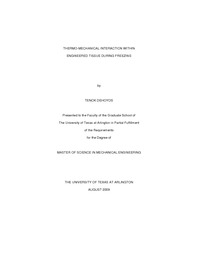
ATTENTION: The works hosted here are being migrated to a new repository that will consolidate resources, improve discoverability, and better show UTA's research impact on the global community. We will update authors as the migration progresses. Please see MavMatrix for more information.
Show simple item record
| dc.contributor.author | Dehoyos, Tenok | en_US |
| dc.date.accessioned | 2009-09-16T18:19:44Z | |
| dc.date.available | 2009-09-16T18:19:44Z | |
| dc.date.issued | 2009-09-16T18:19:44Z | |
| dc.date.submitted | January 2009 | en_US |
| dc.identifier.other | DISS-10367 | en_US |
| dc.identifier.uri | http://hdl.handle.net/10106/1776 | |
| dc.description.abstract | Cryopreservation is the preserving of biological tissues at sub zero temperature. There are many useful applications to cryopreservation such as storing donated organs till they are needed rather than letting them go to waste. When tissues are frozen and thawed, their original functionality and vitality are not usually maintained. It's been shown that when tissue is frozen its mechanical properties change, such as tensile strength and modulus. Each tissue has an extra cellular matrix made up of many collagen fibrils that is responsible for the structural integrity of the tissue. This study is to investigate the structural changes of ECM by freeze/thaw by use of scanning electron microscopy and thermo-mechanical analysis of tissue deformation during freezing. In this experimental study, three types of engineered tissue containing human fibroblast cells were examined for microstructural changes in the collagen ECM. The three types of engineered tissue had variable collagen and cell density. These densities were 1) 3mg/ml of collagen and 200,000 cells/ml 2) 3mg/ml of collagen and 400,000 cells/ml, and 3) 6mg/ml of collagen and 200,000 cells/ml. Changes in fibril area, mean void area and fibril diameter were to be examined. In this study a thermo-mechanical finite element model was developed to predict the location of the freezing front and possible the deformation rate and dilatation of the engineered tissue during freezing. The results indicated that freezing of ET causes the increase of mean void area of voids between fibrils, and the decrease in the average fibril area and the diameters of the fibrils increased. For the model it was found that the location of the freezing front could be predicted, but dilatation and deformation rates could only be predicted close to the order of magnitude of the experimental results. | en_US |
| dc.description.sponsorship | Han, Bumsoo | en_US |
| dc.language.iso | EN | en_US |
| dc.publisher | Mechanical Engineering | en_US |
| dc.title | Thermo-mechanical Interaction Within Engineered Tissue During Freezing | en_US |
| dc.type | M.S. | en_US |
| dc.contributor.committeeChair | Han, Bumsoo | en_US |
| dc.degree.department | Mechanical Engineering | en_US |
| dc.degree.discipline | Mechanical Engineering | en_US |
| dc.degree.grantor | University of Texas at Arlington | en_US |
| dc.degree.level | masters | en_US |
| dc.degree.name | M.S. | en_US |
| dc.identifier.externalLink | http://www.uta.edu/ra/real/editprofile.php?onlyview=1&pid=245 | |
| dc.identifier.externalLinkDescription | Link to Research Profiles | |
Files in this item
- Name:
- DeHoyos_uta_2502M_10367.pdf
- Size:
- 20.02Mb
- Format:
- PDF
This item appears in the following Collection(s)
Show simple item record


